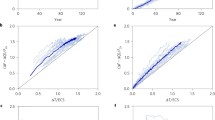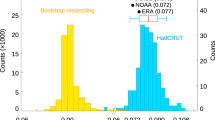Abstract
The transient climate response (TCR) is a highly policy-relevant quantity in climate science. We show that recent revisions to TCR in the IPCC 5th Assessment Report have more impact on projections over the next century than revisions to the equilibrium climate sensitivity (ECS). While it is well known that upper bounds on ECS are dependent on model structure, here we show that the same applies to TCR. Our results use observations of the planetary energy budget, updated radiative forcing estimates and a number of simple climate models. We also investigate the ratio TCR:ECS, or realised warming fraction (RWF), a highly policy-relevant quantity. We show that global climate models (GCMs) don’t sample a region of low TCR and high RWF consistent with observed climate change under all simple models considered. Whether the additional constraints from GCMs are sufficient to rule out these low climate responses is a matter for further research.




Similar content being viewed by others
References
Allen MR, Frame DJ, Huntingford C, Jones CD, Lowe JA, Meinshausen M, Meinshausen N (2009) Warming caused by cumulative carbon emissions towards the trillionth tonne. Nature 458(7242):1163–1166
Andrews DG, Allen MR (2008) Diagnosis of climate models in terms of transient climate response and feedback response time. Atmos Sci Lett 9(1):7–12
Andrews T, Gregory JM, Webb MJ, Taylor KE (2012) Forcing, feedbacks and climate sensitivity in CMIP5 coupled atmosphere-ocean climate models. Geophys Res Lett 39(9)
Boucher O, Reddy MS (2008) Climate trade-off between black carbon and carbon dioxide emissions. Energy Policy 36(1):193–200
Forster PM, Andrews T, Good P, Gregory JM, Jackson LS, Zelinka M (2013) Evaluating adjusted forcing and model spread for historical and future scenarios in the CMIP5 generation of climate models. J Geophys Res Atmos 118(3):1139–1150
Frame DJ, Stone DA, Stott PA, Allen MR (2006) Alternatives to stabilization scenarios. Geophys Res Lett 33(14)
Frölicher TL,Winton M, Sarmiento JL (2014) Continued global warming after CO2 emissions stoppage. Nat Cli Change 4(1):40–44
Gillett NP, Arora VK, Matthews D, Allen MR (2013) Constraining the ratio of global warming to cumulative co2 emissions using cmip5 simulations. J Clim 26(18):6844–6858
Gregory JM, Forster PM (2008) Transient climate response estimated from radiative forcing and observed temperature change. J Geophys Res Atmos 113(D23):1984–2012
Gregory JM, Ingram WJ, Palmer MA, Jones GS, Stott PA, Thorpe RB, Lowe JA, Johns TC, Williams KD (2004) A new method for diagnosing radiative forcing and climate sensitivity. Geophys Res Lett 31(3)
Hegerl GC, et al. (2007) Understanding and attributing climate change. In: Solomon S, Qin D, Manning M, Chen Z, Marquis M, Averyt KB, Tignor M, Miller HL (eds) Climate Change 2007: The Physical Science Basis. Contribution of Working Group I to the Fourth Assessment Report of the Intergovernmental Panel on Climate Change
Huber M, Knutti R (2014) Natural variability, radiative forcing and climate response in the recent hiatus reconciled. Nat Geosci 7:651–656
Huntingford C. (2013) Climate projection: refining global warming projections. Nat Clim Chang 3(8):704–705
IPCC (2007) Summary for policymakers. In: Climate Change 2007: The Physical Science Basis. Contribution of Working Group I to the Fourth Assessment Report of the Intergovernmental Panel on Climate Change
IPCC (2013) Summary for policymakers. In: Climate Change 2013: The Physical Science Basis. Contribution of Working Group I to the Fifth Assessment Report of the Intergovernmental Panel on Climate Change
Knutti R, Joos F, Müller SA, Plattner G-K, Stocker TF (2005) Probabilistic climate change projections for CO2 stabilization profiles. Geophys Res Lett 32(20)
Knutti R, Krähenmann S, Frame DJ, Allen MR (2008) Comment on Comment on “Heat capacity, time constant, and sensitivity of earth’s climate system” by SE Schwartz. J Geophys Res Atmos 113(D15):1984–2012
Kummer JR, Dessler AE (2014) The impact of forcing efficacy on the equilibrium climate sensitivity. Geophys Res Lett 41(10)
Levitus S, Antonov JI, Boyer TP, Baranova OK, Garcia HE, Locarnini RA, Mishonov AV, Reagan JR, Seidov D, Yarosh ES, other (2012) World ocean heat content and thermosteric sea level change (0–2000 m). Geophys Res Lett 39(10):1955–2010
Lewis N (2013) An objective Bayesian improved approach for applying optimal fingerprint techniques to estimate climate sensitivity. J Clim 26(19)
Lewis N, Curry JA (2014) The implications for climate sensitivity of ar5 forcing and heat uptake estimates. Clim Dyn:1–15
Myhre G, et al. (2013a) Anthropogenic and natural radiative forcing: Supplementary material. In: Climate Change 2013: The Physical Science Basis. Contribution of Working Group I to the Fifth Assessment Report of the Intergovernmental Panel on Climate Change
Myhre G, et al. (2013b) Anthropogenic and natural radiative forcing. In: Climate Change 2013: The Physical Science Basis. Contribution of Working Group I to the Fifth Assessment Report of the Intergovernmental Panel on Climate Change
Otto A, Otto FEL, Boucher O, Church J, Hegerl G, Forster PM, Gillett NP, Gregory J, Johnson GC (2013) Knutti, R, and others,. Energy budget constraints on climate response. Nat Geosci 6:415–416
Padilla LE, Vallis GK, Rowley CW (2011) Probabilistic estimates of transient climate sensitivity subject to uncertainty in forcing and natural variability. J Clim 24:21
Rogelj J, Meinshausen M, Sedláċek J, Knutti R (2014) Implications of potentially lower climate sensitivity on climate projections and policy. Environ Res Lett 9(3):031003
Schaller N, Sedláċek J, Knutti R (2014) The asymmetry of the climate system’s response to solar forcing changes and its implications for geoengineering scenarios. J Geophys Res Atmos 119(9)
Schmidt GA, Shindell DT, Tsigaridis K (2014) Reconciling warming trends. Nat Geosci 7(3):158–160
Schwartz SE (2007) Heat capacity, time constant, and sensitivity of earth’s climate system. J Geophys Res Atmos (1984–2012) 112(D24)
Schwartz SE (2012) Determination of Earth’s transient and equilibrium climate sensitivities from observations over the twentieth century: strong dependence on assumed forcing. Surv Geophys 33(3-4):745–777
Senior CA, Mitchell JFB (2000) The time-dependence of climate sensitivity. Geophys Res Lett 27(17):2685–2688
Shindell DT (2014) Inhomogeneous forcing and transient climate sensitivity. Nat Clim Chang 4:274–277
Solomon S, et al. (2007) Technical summary. In: Solomon S, Qin D, Manning M, Chen Z, Marquis M, Averyt KB, Tignor M, Miller HL (eds) Climate Change 2007: The Physical Science Basis. Contribution of Working Group I to the Fourth Assessment Report of the Intergovernmental Panel on Climate Change
Winton M, Takahashi K, Held IM (2010) Importance of ocean heat uptake efficacy to transient climate change. J Clim 23(9):2333–2344
Yamazaki K, Rowlands DJ, Aina T, Blaker AT, Bowery A, Massey N, Miller J, Rye C, Tett SF B, Williamson D, et al. (2013) Obtaining diverse behaviors in a climate model without the use of flux adjustments. J Geophys Res Atmos 118(7):2781–2793
Acknowledgments
RJM is supported by a NERC and Met Office CASE studentship. JAL and WJI were supported by the Joint DECC/Defra Met Office Hadley Climate Centre Programme (GA01101). MRA was supported by the Oxford Martin School and DECC contract TRN 307/11/2011. WJI and MRA were also supported by NERC under projects NE/I00680X/1. PMF was supported by EPSRC grant EP/I014721/1 and a Royal Society Wolfson Merit award.
Author information
Authors and Affiliations
Corresponding author
Electronic supplementary material
Below is the link to the electronic supplementary material.
Rights and permissions
About this article
Cite this article
Millar, R.J., Otto, A., Forster, P.M. et al. Model structure in observational constraints on transient climate response. Climatic Change 131, 199–211 (2015). https://doi.org/10.1007/s10584-015-1384-4
Received:
Accepted:
Published:
Issue Date:
DOI: https://doi.org/10.1007/s10584-015-1384-4




